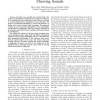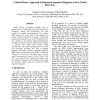2711 search results - page 85 / 543 » Mapping sequences by parts |
BIBM
2007
IEEE
14 years 2 months ago
2007
IEEE
Chewing is an essential part of food intake. The analysis and detection of food patterns is an important component of an automatic dietary monitoring system. However chewing is a t...
EVOW
2010
Springer
14 years 1 months ago
2010
Springer
A challenging problem in bioinformatics is the detection of residues that account for protein function specificity, not only in order to gain deeper insight in the nature of functi...
EDOC
2008
IEEE
14 years 12 days ago
2008
IEEE
Model Driven Development (MDD) aims to promote the role of modeling in Software Engineering. Enterprise systems and architectures are often modeled via multiple representations. F...
BNCOD
2003
14 years 1 days ago
2003
There are two aspects to the work being presented here. The first is a novel persistent index structure for genomic data, a prototype of which has been completed. The second, usin...
GECCO
2008
Springer
13 years 11 months ago
2008
Springer
This paper describes a multi-objective memetic approach for solving multi-objective flexible process sequencing problems in flexible manufacturing systems (FMSs). FMS can be des...


